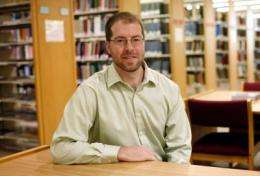This is Tom Nelson Laird. Credit: Indiana University
An Indiana University study that analyzed differences in practices between faculty at historically black colleges and universities (HBCUs) and predominantly white institutions (PWIs) found that faculty members at HBCUs were more likely to engage students in certain "educationally purposeful" activities both in and out of the classroom.
The study was conducted by Tom Nelson Laird, associate professor in the higher education and student affairs program in the Indiana University School of Education. Nelson Laird also works on the National Survey of Student Engagement and its related surveys. Co-authors include higher education doctoral students Mahauganee Shaw, Eddie Cole and Cameron Harris.
Educationally purposeful activities, those that lead to deep levels of learning and the production of enduring and measurable learning gains and outcomes, are part of the basis for the highly regarded National Survey of Student Engagement. The more that students are engaged with educationally purposeful activities, the better the quality of the institution.
Nelson Laird said studies based on the National Survey of Student Engagement have documented similar differences between HBCUs and PWIs from the students' perspective but until now, no studies have examined faculty differences.
"Faculty differences largely confirm what has been found among students," Nelson Laird said. "Compared to their counterparts at the PWIs in this study, faculty at HBCUs viewed their campuses as more supportive of students, used active classroom practices more, placed greater importance on reflective learning, and placed greater emphasis on personal and social responsibility."
Other findings included HBCU faculty viewing student relationships with each other, faculty, administrators, and staff less positively than faculty at PWIs. The faculty at HBCUs were disproportionately African-American, with larger proportions of Asian and Asian-American faculty compared with PWIs. A larger proportion of the HBCU faculty were from the hard sciences.
"These differences in who teaches at HBCUs contributes to the differences found between teaching practices and the view of student relationships between HBCUs and PWIs," Nelson Laird said.
He said the work is important for confirming evidence previously coming only from students. The findings also support the notion that diversifying faculty at PWIs would positively influence teaching and learning.
"This work also supports the idea that there is something particularly supportive about HBCUs," Nelson Laird said. "It likely has more to do with their approach to teaching and support and is not all about students relationships with others on campus."
More information: "Patterns in Faculty Teaching Practices on the Campuses of Historically Black Colleges and Universities and Predominantly White Institutions" will be presented at 5:15 p.m. EDT Tuesday at the American Educational Research Association annual meeting in Vancouver.
Provided by Indiana University



















